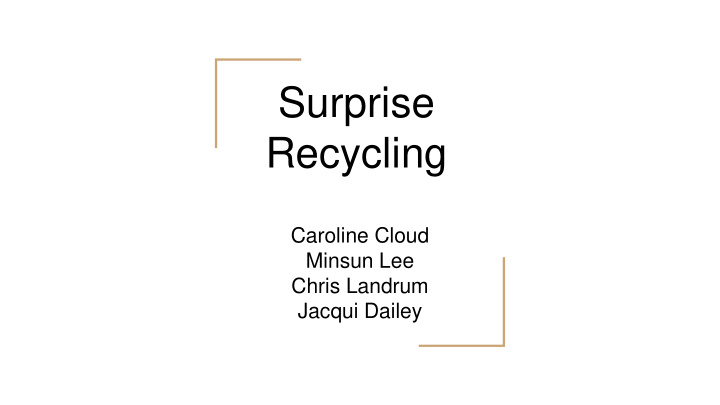



Surprise Recycling Caroline Cloud Minsun Lee Chris Landrum Jacqui Dailey
Challenge Area Sustainability Challenge Area / Problem - The challenge for the City of Surprise’s Recycling Center is the continuous failure in recycling audits and solid waste contamination. “The acceptable level of contamination per contract with Waste Management is no greater than 25%, and the contamination was running anywhere from 26% to as high as 40%.” ○ Project Objective -Specific goals are to increase the city’s current waste diversion percentage from 22% to greater than 25% and ultimately up to 40% within the next 3 to 5 years. Another specific goal is to decrease recycling contamination from the current rate of 25% to below 15% within the next year. ○ Research questions -What and how have other cities/communities done in the past to mitigate contamination rates? -What projects have failed? - What current policies may be restricting efficient recycling? -What kinds of barriers are there for people to not recycle? Community Partner (s) -We worked with the City of Surprise Recycling Center, including Ms. Christina Betz.
Progression Conducted an interview with Ms. Betz to obtain more needed information on the department. Information given: Responsible for residential waste/recycling; no commercial waste/recycling Contract with Waste Management-materials recovery facility Individual research to determine stakeholder engagement Farmers Community residents NGO’s Municipalities Individual research on disciplinary approaches Economic incentives Education
Barriers Waste & Resources Action Program (WRAP) commissioned research project in 2007 understand what prevents household recycling. Current recyclers (94% of the sample), have significant barriers that prevented them from recycling as much as they could. 86% of the sample: Attitude barrier . This large percentage of households said they would be inclined to recycle more if they saw an improvement in their local area. 52% of the sample: Situational barriers . This percentage of current recyclers said they would recycle more if recycling had a wider variety of materials to collect . The last two obstacles, tied at 48%, were behavioral and understanding barriers . People just are not sure if certain things are recyclable and trash them instead. Others clearly understood that they were throwing recyclables in the trash.
Residential Program With Success San Francisco has implemented a mandatory recycling and composting system that requires the residents to separate their recyclables, landfills, and compostables. It has been executed by accessibility; the city dealt 3 different colored bins (green, blue, black) to every property. Initially when the bins were distributed, the law was not mandatory and in place. Garbage officials were quickly shocked at the greater amount of food and compostables flowing through their organic annex. Benefits of the program were it cost the city very little, cut costs for garbage disposal, simply reduced the bad smell of garbage. More @ http://sfenvironment.org/zero-waste/recycling-and-composting
Residential Program Failure When implementing a citywide program, being cautious is very important. Taking a shot in the dark is not wise, as we can take a look at previous ideas around the country that have not succeeded. One example of a failing project was in Chicago, 1995. There was a ‘Blue Bag’ program where residents were told to place recyclables into specific blue bags, and then into the waste bins. These were the same bins containing the other wastes, in effort to separate landfill from recyclables by blue bags. From there, machines and workers were to separate the wastes. The program ran for 15 years but the result costed taxpayers $60 million for these ‘state of the art’ facilities and was finally shut down after falling vastly short of expectations. The facilities now serve a different purpose; the city quickly had better results from switching to large blue recycle bins. More @ http://www nytimes com/2010/03/05/us/05cncway html? r=1
Economic approaches • Because of the high contamination rate, the City of Surprise lost its benefits of getting $16,000 to $18,000 for a month in addition to the cost that it paid for trash disposal. • The low awareness of how to recycle properly and the low incentive to do recycling properly might be the problems. • To enhance the awareness... ○ Collaborating with non-government organizations by making campaigns to give specific and legal knowledge about recycling. • Incentive ○ Employing a mandatory recycling program. ○ Adopting a variable rate system by exercising fines or taxes. Ex) rate system depending on the amount of trash that individuals make. Pay-As- You-Throw ○ Introducing reward program by point accumulation system.
Contamination Plan Create plastic bag “leave one/take one” at dog parks, city parks, and neighborhoods Continue outreach at local festivals/fairs ● Create a “Recycle Wise in Surprise” Facebook page ● Connect with Sustainable Surprise Facebook page ● Create a contest through social media ○ Have residents like the page when at festivals/fairs ○ Residents then will be entered to win a prize when they like and share a post from your page ○ Prize will be a giftcard to a local business (birt’s bistro)
Waste Diversion Plan Start recycling/composting in city buildings/schools Join forces with Recycled City (composting company) Use vacant land in Surprise for composting/community garden
Remaining Challenges/ What’s still unknown? What are some remaining challenges? - People are still contaminating due to certain barriers, such as attitudes, situations, and understanding. - Education is one of the best methods to resolving major issues with contamination. - Recycled commodity prices are dropping - How can you help?? Recycle! Tell your friends, family. Lead by example!
Resources Mixed Recycling at our Facilities. (n.d.). Retrieved February 24, 2016, from http://swm.maricopa.gov/recycling.htm Recycled City http://www.recycledcity.com Recycling Perks www.recyclingperks.com/#/blog Incentive Programs for Local Government Recycling and Waste Reduction, from www.cal r ecycle.ca.gov/
Recommend
More recommend